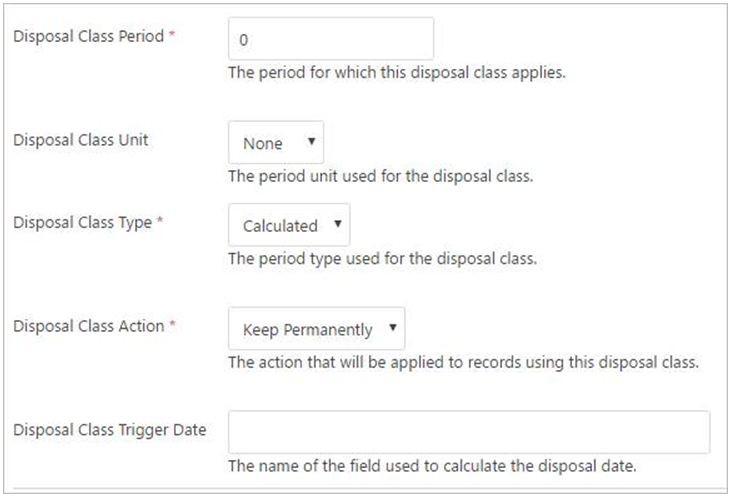Managing Outcomes
Outcomes are sometimes referred to as disposal classes. Essentially, an outcome is where a retention period is attached to a function and activity i.e. this is where the record belongs in the classification scheme, this is how long it needs to be retained for, based on this date event and what needs to happen when this date is reached.
Search for Outcomes
To manage large sets of outcomes, use the search control at the top right of the Outcomes page to filter the list of Outcomes. This search control can filter by Title, Classification, Disposal Class Number, Disposal Class Description or Disposal Class Trigger Date.
Create an Outcome
To create an Outcome in RecordPoint:
- From the Rules menu, select Outcomes
- Select Add New Item
- Populate the Outcome form
- Title: Provide a title for the outcome. Try and use a descriptive title as it will help with identification when creating rules. Tip Use the classification, action, retention period and disposal class number (as per example 1)
- Classification: Select the classification given to records using this Record Class. Use the Browsing Icon on the right hand side to select a valid classification. Note: Classification must have already been created in the term store.
- Disposal Class Number: Provide the disposal class number
- Disposal Class Description: Provide the disposal class description (not mandatory). These are sometimes referred to as scope notes.
- Disposal Class Period: Provide the retention period or the period for which this disposal class applies. Note: If retention is keep permanently, populate this field with '0'
- Disposal Class Unit: Provide the period unit used for the disposal class Note: If retention is to keep permanently then select 'None'
- Disposal Class Type: Leave disposal class type as “calculated”
- Disposal Class Action: Select a disposal class action (destroy, keep permanently, transfer, review). This action will be applied to records using the specified disposal class.
- Disposal Class Trigger Date: Specify the name of the field used to calculate the disposal date. Definition: Trigger dates are utilized by RecordPoint to calculate retention periods for disposal/transfer/review. These date fields can be system generated for custom, to meet individual retention requirements. Examples of trigger dates include: Date created, date last modified, claim date and business closure. Note: If retention is to keep permanently then leave this field blank.
Keep Permanently example
- Click Save
Example
- Financial Management – Accounting – Destroy – 5 years –Date Created
This means the disposal class outcome of files in the term group Financial Management and term set Account will be destroyed 5 years from the specified trigger date ‘Date Created’. - Legal Services – Advice – Review – 7 years – Last Modified
Where possible, system generated dates should be used, as these do not place any additional responsibility on the user.
For example, if retention on a given record is calculated based on business closure, it is not possible to capture this automatically. Subsequently, in order for retention to be calculated the business closure date would need to be entered when this event occurred.
However, even in these circumstances, RecordPoint will still capture, classify and apply a retention schedule to the record as soon as it is added to the system, regardless of the existence of a trigger date
Examples of good practice in defining outcomes
| Classification | Retention | Authority Number | Trigger Date | Action | Scope Notes |
Policy – Agency Wide Policy – 13.1.1 | Keep Permanently | 13.1.1 | Created | Records documenting a policy, including its formulation, or functional activities, strategic planning and management matters affecting the whole agency. | |
Policy – Procedures – 13.3.1 | 7 Years | 13.3.1 | Modified | Destroy | Records of an agency’s procedures including manuals, handbooks, directives etc |
Contracting – Out – Contracts – 3.3.1 | Keep Permanently | 3.1.1 | Created | Summary records for all contracts managed by an agency. Includes contract registers and systems. |
